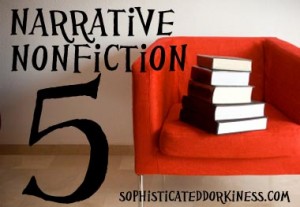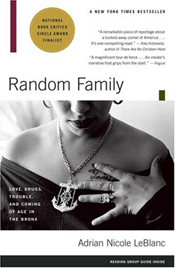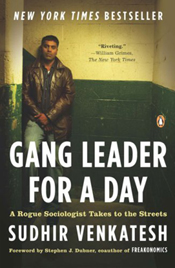 The inaugural edition of Narrative Nonfiction 5 features five books by authors that went in-depth covering “current” events in the United States. I put current in quotes because most of these books are more than 10 years old, which makes current a bit of a stretch. Still, I’m fairly confident many of these issues haven’t changed so much that the lessons of the story aren’t relevant today.
The inaugural edition of Narrative Nonfiction 5 features five books by authors that went in-depth covering “current” events in the United States. I put current in quotes because most of these books are more than 10 years old, which makes current a bit of a stretch. Still, I’m fairly confident many of these issues haven’t changed so much that the lessons of the story aren’t relevant today.
The authors of these books spent an extensive amount of time with the subjects they covered, which resulted in books with rich details and a level of nuance about subjects many people don’t get the chance to understand.
1. Random Family by Adrian Nicole LeBlanc
 In Random Family, journalist Adrian Nicole LeBlanc spent 10 years living in the Tremont Avenue area of the Bronx. She follows the twisting lives of two couples — Jessica and her heroin dealer boyfriend Boy George, and Jessica’s brother Cesar and his on-again/off-again girlfriend Coco. Over the time LeBlanc spent there, three of the four ended up in jail, while Coco mothers more children than she can afford.
In Random Family, journalist Adrian Nicole LeBlanc spent 10 years living in the Tremont Avenue area of the Bronx. She follows the twisting lives of two couples — Jessica and her heroin dealer boyfriend Boy George, and Jessica’s brother Cesar and his on-again/off-again girlfriend Coco. Over the time LeBlanc spent there, three of the four ended up in jail, while Coco mothers more children than she can afford.
I read this book earlier in the year after it was named on one of Newsweek’s Fifty Books for Our Time. I think it’s earned that reputation — LeBlanc writes about her subjects with sympathy, but also honesty, not sugar-coating their actions or the potential implications. It’s an enlightening book, both for its subject and the effort that LeBlanc went into reporting and writing this story.
2. A Prayer for the City by Buzz Bissinger
Politics can be supremely fascinating, or really dull, it just depends how it’s written. Luckily, Buzz Bissinger’s book A Prayer for the City makes it awesome. In order to write Prayer for the City, Buzz Bissinger was granted 24-7 access to Ed Rendell during his first term as mayor of Philadelphia and his staff. Bissinger spent four years with the administration while they worked to deal with an out-of-control budget, overly powerful unions, and racial tensions that threatened to tear the city apart. He saw negotiations, meetings, and a tremendous number of private moments where Rendell started to fall apart.
What works best about this book is that although Bissinger likes Rendell, he doesn’t let him off the hook. Bissinger profiles a number of Philadelphia residents (who both like and dislike Rendell) to humanize the political topics Rendell is dealing with. The book is a long-term, insider look at a man and what it takes to be in charge of a major U.S. city. It helped me to see politics from this perspective because it gives a sense of why politics can do good or get stalled up and do no good at all.
3. Nickel and Dimed by Barbara Ehrenreich
I haven’t reviewed Nickel and Dimed on this blog, but I did read it a number of years ago in college. In the book, Ehrenreich goes undercover to explore what impacts welfare reform had on the working poor. Between the spring or 1998 and summer of 2000, Ehrenreich worked minimum wage jobs in Florida, Maine, and Minnesota for a month each to see if she could live off those wages. In most cases, she could not.
This book is on the list because it’s such a well-known book, and a good example of undercover journalism on an important topic. But unlike the previous two books on this list, Ehrenreich doesn’t attempt to be an unbiased observer of the story — this is her lived, editorialized, experience. I don’t think that makes the reporting less valid or accurate, it’s just a different way to get at the issue of the urban and working poor.
4. Gang Leader for a Day by Sudhir Venkatesh
 In Sudhir Venkatesh’s memoir Gang Leader for a Day, Venkatesh writes about his years studying the Robert Taylor Homes in the ghetto of Chicago. Venkatesh was a young sociology student when he first entered the Robert Taylor homes, but with a stroke of luck (and stupid bravery), he became friends with a local gang leader, J.T., which gives him access to study the underground economy of the area.
In Sudhir Venkatesh’s memoir Gang Leader for a Day, Venkatesh writes about his years studying the Robert Taylor Homes in the ghetto of Chicago. Venkatesh was a young sociology student when he first entered the Robert Taylor homes, but with a stroke of luck (and stupid bravery), he became friends with a local gang leader, J.T., which gives him access to study the underground economy of the area.
I enjoyed this book because, again, it provided an intimate look at a place I don’t have any conception about. It changed some of my opinions about gang life and gang influence as well as frustrated me with how little anyone seemed to be able to do. The book is also problematic because of Venkatesh’s methods — he often was oblivious to the serious problems his research might have caused his subjects. However, he was honest about his mistakes which is something to be happy about.
5. There Are No Children Here by Alex Kotlowitz
This is the one book on the list I haven’t read, but I’ve heard good thing about it a number of sources. Kotlowitz was a Wall Street Journal reporter who met brothers Lafayette and Pharoah Rivers in 1985 when they were living in the Chicago ghetto. There Are No Children Here follows them boys growing up with their mother, absent father, and siblings, in a housing project controlled by gangs and respond to their challenges in very different ways. The book takes place in a similar time and place to Gang Leader for a Day, but the focus on two children is very different which makes it a book I hope to read and would love to learn more about.
Thanks for reading through my first Narrative Nonfiction 5 post! If you know of other books on this topic, I’d love to add them to the borrow of the list! Also, if you have suggestions for a Narrative Nonfiction 5 post or would like to write a guest post, please send me an e-mail at sophisticated.dorkiness [at] gmail [dot] come.

Comments on this entry are closed.
These are all good picks. I remember flirting with the LeBlan book several times at the bookstore but it never made it home with me. It just might now that I know you liked it.
Nicole: I really loved Random Family. LeBlanc did an amazing job with it, and her dedication pays off. I hope you get a chance to read it.
What a great list! I have heard of Random Family but not read it. We had considered it for a book event at our store but are going with a different one instead. I really liked There Are No Children Here and now will look into A Prayer for the City. I didn’t like Nickel & Dimed at all. I thought it was more about HER than about anything else.
Aarti: I’m glad to hear you liked There Are No Children Here. I haven’t read it, but heard good things. I read Nickel & Dimed a long time ago, so I don’t remember all the specifics. But of course her using herself to tell the story could have that impact — I should read it again.
These all look good to me, especially Nickel and Dimed.
bermudaonion: I think that one was good — I read it in college, so I can’t remember all the details. It’s an important book, nonetheless.
I’ve read both Nickel and Dimed and Random Family and strongly second your recommendations of both!
Florinda: Yay, I’m glad!
These all sound so interesting. I’ve definitely seen and heard of Nickel and Dimed, although I have not read it. There Are No Children Here really seems like one I should read, being that I live in Chicago and work with children of poverty. Great first post for Narrative Nonfiction 5! I can’t wait to read more!
Julie: Given your job and background, I think There Are No Children Here would be a very good one. Let me know what you think of it if you get a chance to read it.
There Are No Children Here is an incredible book ! I highly recommend it !
Sad to say I’ve heard about most of these books but haven’t read any of them yet. I think Random Family is the book I want to read the most.
This is a great feature. Keep the lists coming!
Vasilly: Thanks, I’m glad the list was decent. These are pretty well-known books, so I hope I can find some more less famous ones for the next list. Random Family is probably my favorite on the list.
These look like great books! In particular, I really want to read Gang Leader for a Day. I think it’s amazing the dedication these writers have to their research, even when they screw up.
Jenny: The dedication it took to write these books is part of what impressed me about them. It takes a lot of time, support, and courage to invest into a project like these and I think it should be recognized by having readers 🙂
I read Nickel and Dimed in college and it was fantastic. I have been wanting to read Random Family for a while and now I have a few more to add to my list.
Jess: Awesome, I’m always glad to add to a TBR list 🙂
I love this new feature! Not enough good nonfiction is reviewed on the book blog circuit. Thanks for filling the gap 🙂
A Bookshelf Monstrosity: You’re welcome, and I couldn’t agree more. There’s a lot of fiction, but not as much nonfiction. Hopefully the feature can help change that.
I love this new feature too! I’ve heard of a couple of these books, but haven’t read any of them. Random Family sounds fascinating.
avisannschild: Random Family was a very, very good book. I highly recommend it.
Random Family was one of the best books I read last year. I read later that on occasion the author would leave tape recorders with the people whose lives she was observing and tell them to just say whatever they wanted into it. This is the link where I read that:
http://www.newnewjournalism.com/bio.php?last_name=leblanc
Christy: Thanks for that link — it’s an interesting tidbit I didn’t know about the book. I actually have the book that website is about on my shelf, but I never finished reading all the way through it… shame on me 🙂
I’m so glad to see Gang Leader on your list!
I think The Immortal Life of Henrietta Lacks could be on this list, as well. Even though she died in 1951, the issues the book raises (medical ethics, medical consent, scientific research, who really “owns” cells and tissue) are very timely.
softdrink: The Immortal Life… is definitely going to be on a list. I’m not sure if it’ll be with medical books or what, but it’s a good one.